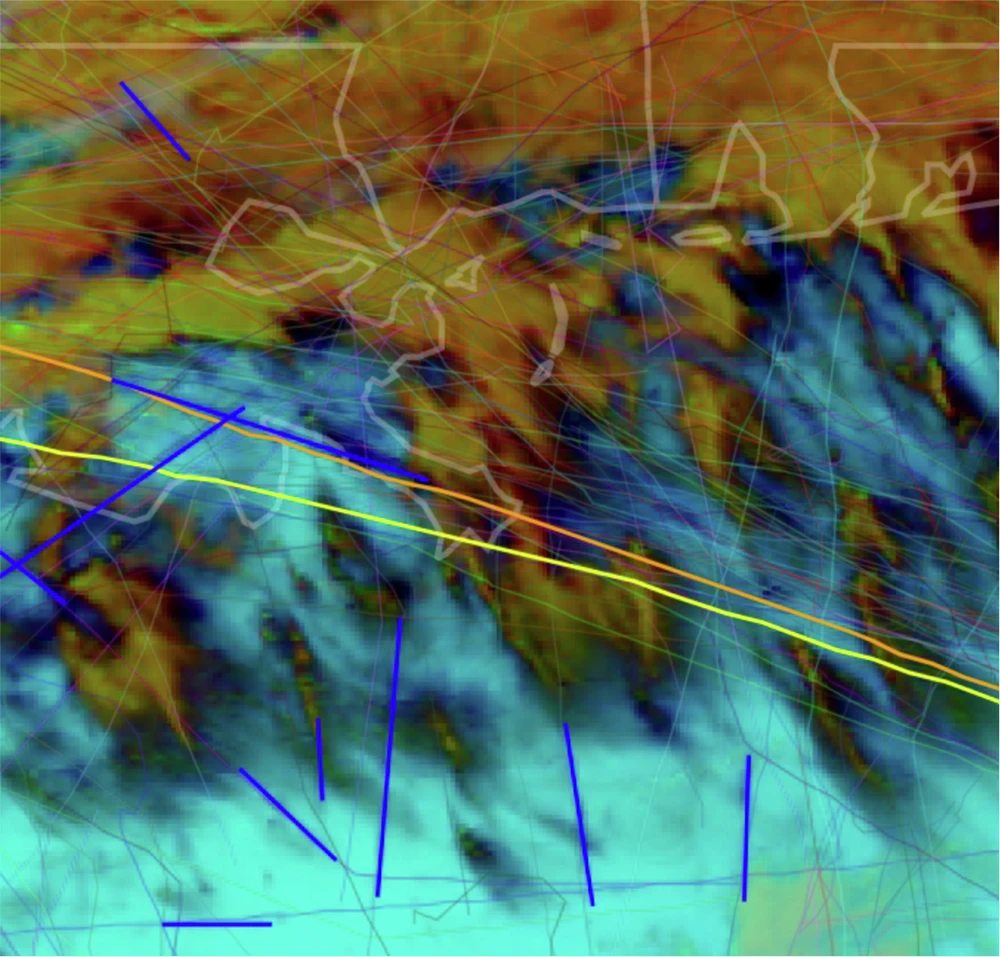Overview
ContrailWatch is a set of flight-level contrail attributions that are computed using the methods described in Sarna et al. 2025, building on top of Geraedts et al. 2023.
These attributions have been used to train ML-based contrail forecasts, evaluate contrail avoidance trials, and to provide insights into contrail formation patterns. We hope that the data will be used to accelerate contrail research.

Example of one frame of the GOES-16 satellite imagery sequence over the Gulf Coast area. This was used for evaluating whether a contrail avoidance flight created a detectable contrail. Thick lines show the original flight path and wind-advected flight trajectory, along with contrails detected by the computer vision system. More details available in the original paper.
Limitations
Geographical coverage: the attributions are only available over a subset of the GOES-East-visible region. Coverage may be expanded in the future.
Formation-focused: the attributions are based on observations of contrail formation from satellite imagery and not direct observation of radiative forcing. An estimated effective energy forcing is provided based on CoCiP-derived climatological averages (Schumann 2012; Platt et al. 2024). The methodology for estimating energy forcing is an active area of research and may change in future versions..
High-precision: the attributions may not represent the full extent of contrail formation over the region. Understanding the percentage of contrail formation that is observable in satellite imagery is an open research question. Recent research indicates that around half of all contrails are detectable in geostationary satellites, with the overwhelming majority of warming coming from contrails that are detectable at some point in their lifetime (Driver et al. 2025).
References
Geraedts, Scott, Erica Brand, Thomas R. Dean, Sebastian Eastham, Carl Elkin, Zebediah Engberg, Ulrike Hager, et al. 2023. A Scalable System to Measure Contrail Formation on a per-Flight Basis. Environmental Research Communications, http://doi.org/10.1088/2515-7620/ad11ab.Sarna, A., Meijer, V., Chevallier, R., Duncan, A., McConnaughay, K., Geraedts, S., and McCloskey, K.: Benchmarking and improving algorithms for attributing satellite-observed contrails to flights, Atmospheric Measurement Techniques, https://doi.org/10.5194/amt-18-3495-2025.
Schumann, U. 2012. "A Contrail Cirrus Prediction Model." Geoscientific Model Development 5 (3): 543-80.
John C Platt, Marc L Shapiro, Zebediah Engberg, Kevin McCloskey, Scott Geraedts, Tharun Sankar, Marc E J Stettler, Roger Teoh, Ulrich Schumann, Susanne Rohs: The effect of uncertainty in humidity and model parameters on the prediction of contrail energy forcing 2024 Environ. Res. Commun. 6 095015
Driver, O. G. A., Stettler, M. E. J., and Gryspeerdt, E.: Factors limiting contrail detection in satellite imagery, Atmos. Meas. Tech., 18, 1115–1134, https://doi.org/10.5194/amt-18-1115-2025, 2025.